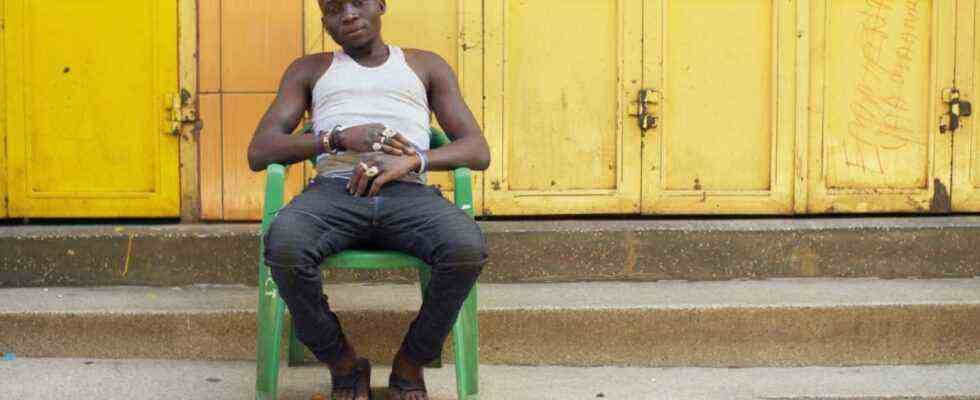At the beginning there is a white plastic chair in a backyard of a German city. Rain pelts down on him, a bale of hay blows past. The chair can withstand anything, is stable and weatherproof. Crash test passed. But is it also suitable as a subject for a documentary film?
Hauke Wendler asks himself this question at the beginning of his documentary film “monobloc”, whose main protagonist is that mostly white, plastic, one-piece chair that everyone has sat on and that is said to exist over a billion times worldwide. The filmmakers use more than 150 of these chairs to form the word “Monobloc” on a sandy beach and film the lettering from above with a drone. Looks nice. Except that the chair itself is such a common, ubiquitous and totally inconspicuous object that it automatically raises doubts as to whether it’s even worth filming.
In Germany, the monobloc does not have such a good reputation.
(Photo: Pier 53)
First, Wendler traces the history of the furniture in Italy and France, goes to a German design museum, where the monobloc now has a permanent place, and realizes that during the plastic boom in the 1970s, the chair was a lifestyle object that was used in advertising images associated with romantic candlelight dinners.
Cold, ugly, cultureless: The criticism of the chair in the rich West is great
In the meantime, the monobloc is more likely to be in front of the director’s weekend cabin, in front of the Asian restaurant around the corner, in front of the beer garden and the pub by the lake. Otherwise he enjoys a miserable reputation in Germany. Wendler noticed this when he went downtown with a mobile studio and asked passers-by to give him their perspective on the monobloc. Cold, ugly, tasteless, badly designed, cultureless, but above all: The seat on which his critics sit in front of Wendler’s camera must be called environmentally harmful. One even takes a chair and smashes it into thousands of pieces on the floor to demonstrate the lack of material. Better to stand then.
Wendler has problems. The financing is slow, the research drags on, the monobloc’s reputation is terrible – and we’ve only got half an hour of film behind us. The meaning of his film, so much is now clear, is linked to the value of the chair. This is exactly what makes the film interesting and puts Wendler under pressure, who has little choice but to document the process of creating his documentary himself and to prove that people in other parts of the world are more interested in the monobloc than the Germans. Because he has a different value for them.
Often the only affordable piece of furniture: the monobloc.
(Photo: Pier 53)
On the Internet, Wendler comes across pictures from Africa in which the monobloc has been transformed into a mobile vehicle. So he travels to Uganda. Here he meets people who are paralyzed but also cannot afford a proper wheelchair. That’s where the work of a nonprofit called Free Wheelchair Mission comes in, combining monobloc chairs with wheeled frames and distributing the inexpensively made vehicles to those in need. In California, Wendler visits the founder of the organization, a former mechanical engineer in the medical sector. When he remembers the first time he saw a paralytic in one of his monobloc wheelchairs, tears came to his eyes.
The global south is more creative: it converts the monobloc into a wheelchair
Take that, you German haters of cheap chairs. Here at home, outside of design museums, the monobloc may be looked down on with contempt, while people in the Global South get creative with it and even build wheelchairs with it. In this context, the monobloc is not only used for sitting – it even gives people back a bit of mobility.
Apart from that, as Wendler shows on another trip to India, it is simply an affordable piece of furniture for the world’s poor, an alternative to squatting on the floor. He provides work for others, such as the foreman in the Indian plastics factory, who wants to give his children a better life with his salary, or the garbage collector in Rio de Janeiro, who also makes a living from the monobloc as soon as it has become plastic waste and sells it on as recyclable material can be. From which, as we already suspect, a new monobloc can emerge.
Dealing with the monobloc makes the massive inequality between the West and the global South visible.
(Photo: Pier 53)
In this way, Wendler is gradually discovering to what extent his film about the chair was worth it. Because it stands less for itself than, like his film, does that make other things visible: the people who sit on it, the different uses they derive from it, the massive inequalities between the West and the global South. It also allows German documentary filmmakers to travel the world. Not bad either.
monobloc, Germany 2021. Direction and script: Hauke Wendler. Camera: Boris Mahlau. Editor: Sigrid Sveistrup. Edition Salzgeber, 90 min.

